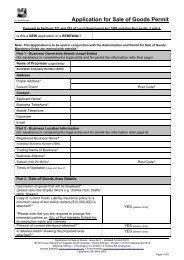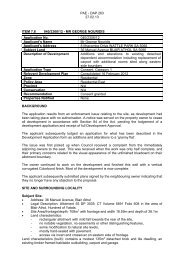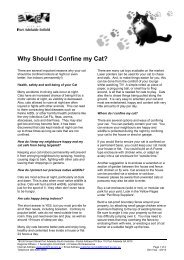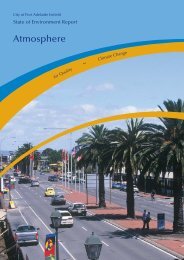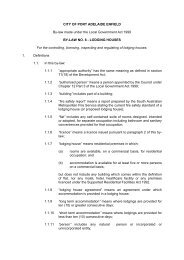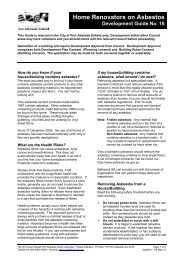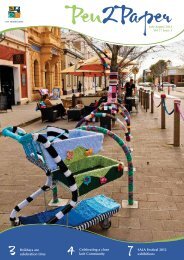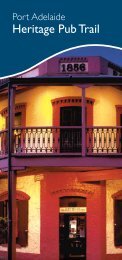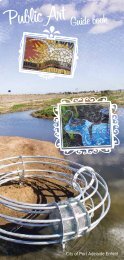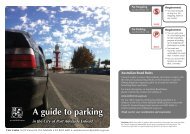Coasts & Estuaries - City of Port Adelaide Enfield - SA.Gov.au
Coasts & Estuaries - City of Port Adelaide Enfield - SA.Gov.au
Coasts & Estuaries - City of Port Adelaide Enfield - SA.Gov.au
You also want an ePaper? Increase the reach of your titles
YUMPU automatically turns print PDFs into web optimized ePapers that Google loves.
Coast & <strong>Estuaries</strong>Pressure Indicator: C<strong>au</strong>lerpa taxifolia growth in the upper <strong>Port</strong> <strong>Adelaide</strong> RiverIn March and April 2002 distribution surveys <strong>of</strong> the extent <strong>of</strong> the C<strong>au</strong>lerpa taxifolia infestation in the<strong>Port</strong> <strong>Adelaide</strong> River were conducted, these observations found a significant population <strong>of</strong> the alga,particularly northwards <strong>of</strong> the Railway and Jervois Bridges, with further small patches and singleplants extending as far as the Birkenhead Bridge (refer to Figure 26). Eradication measures wereundertaken to manually eradicate and control the spread. Despite these efforts by the end <strong>of</strong>December 2003 large areas <strong>of</strong> healthy C.taxifolia remained in the upper <strong>Port</strong> <strong>Adelaide</strong> River and anoutbreak in southern Barker Inlet indicated that the C<strong>au</strong>lerpa population in the upper <strong>Port</strong> <strong>Adelaide</strong>River was not fully contained.In follow up to this work, surveys <strong>of</strong> the upper <strong>Port</strong> <strong>Adelaide</strong> River were conducted in January andFebruary 2004 to determine changes in the distribution <strong>of</strong> C.taxifolia. In 2004 C.taxifolia in the upper<strong>Port</strong> <strong>Adelaide</strong> River is spread over two main areas, one mostly south <strong>of</strong> Jervois Bridge and a secondarea parallel to shore upstream <strong>of</strong> the Birkenhead Bridge (refer to Figure 27). The combined areacovered is approximately estimated to between 9-12ha (blue and pink shaded areas on Figure 27)although this includes potentially large bare areas.There were some differences in the distribution from the 2002 survey to the 2004 survey. However itshould be noted due to differences in survey methods and environmental constraints, comparison isproblematic. A large shallow zone <strong>of</strong> patchy weed observed in 2002 to the north <strong>of</strong> the Railway Bridgewas not present in 2004, otherwise the distribution in 2004 roughly correlates with that observed in2002, indicating that the eradication measures employed in this area have been ineffective.Pollution inputs to the <strong>Port</strong> <strong>Adelaide</strong> River included annual doses <strong>of</strong> 68 tonnes <strong>of</strong> phosphorus and(previously) 460 tonnes <strong>of</strong> nitrogen by the <strong>Port</strong> <strong>Adelaide</strong> sewage treatment works (now diverted toBolivar), as well as significant heavy metal contamination from various industrial and diffuse sources.This places pressure on native plant growth to compete with and combat the weed infestation (EPA,2002).Photo <strong>of</strong> C<strong>au</strong>lerpa taxifolia (Source: PIR<strong>SA</strong> - Environmental Issues - C<strong>au</strong>lerpa Taxifolia)146



